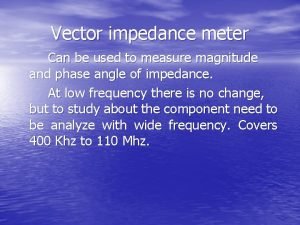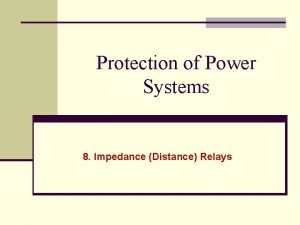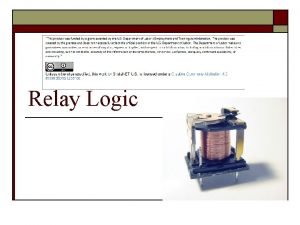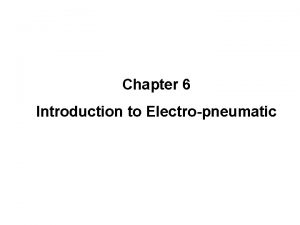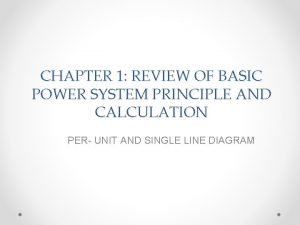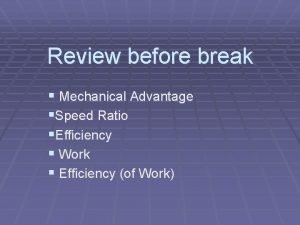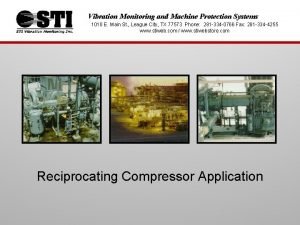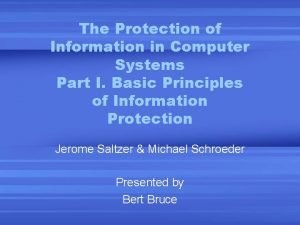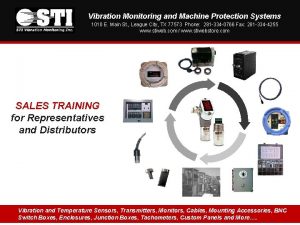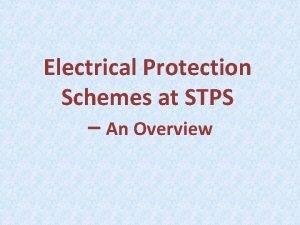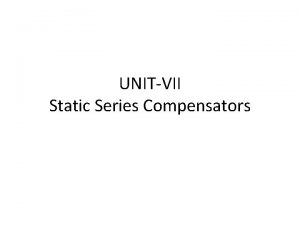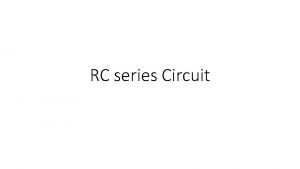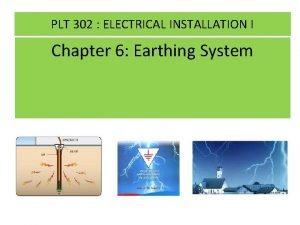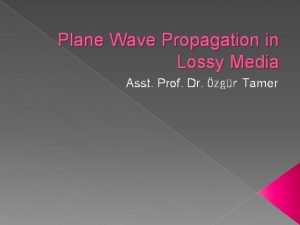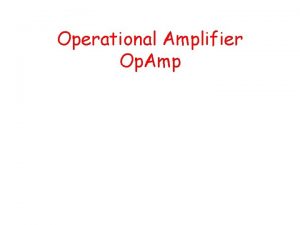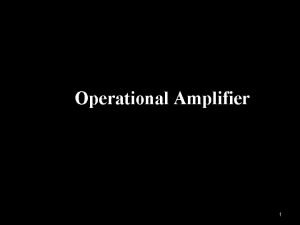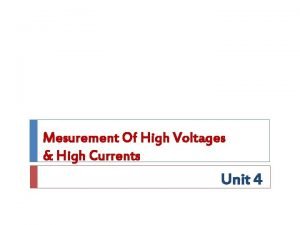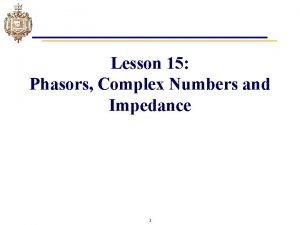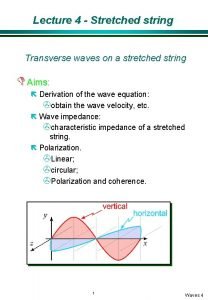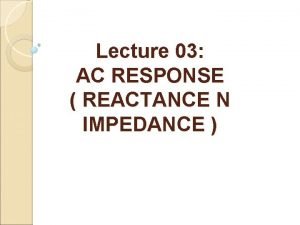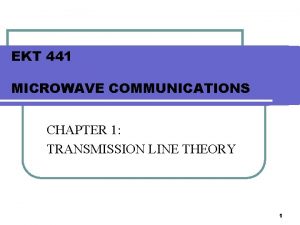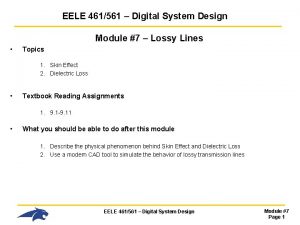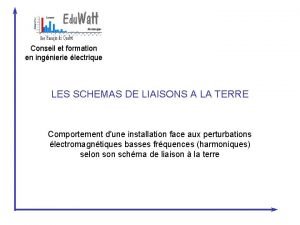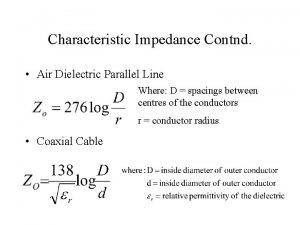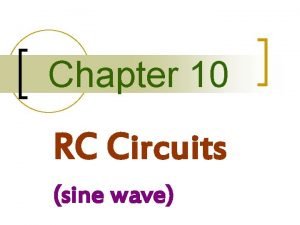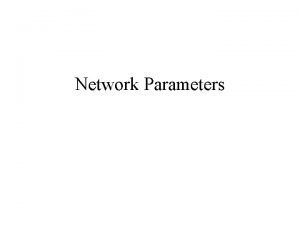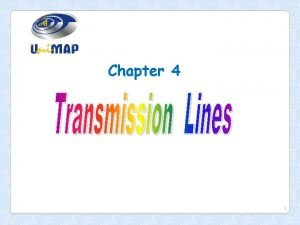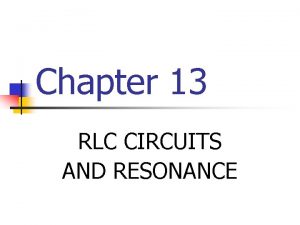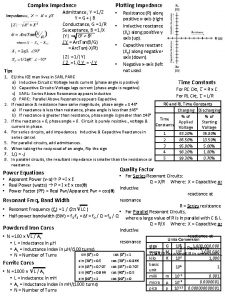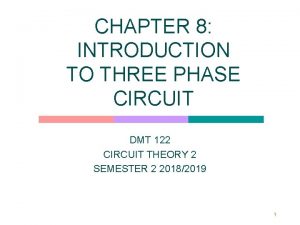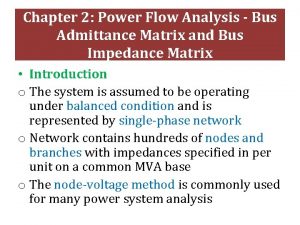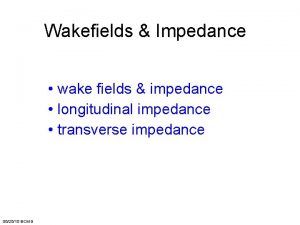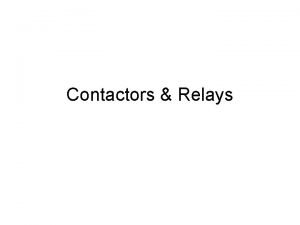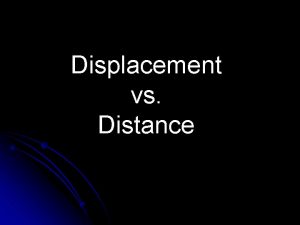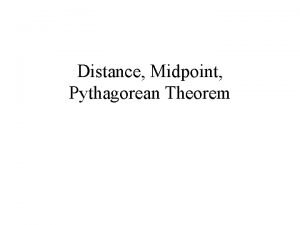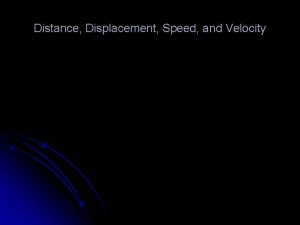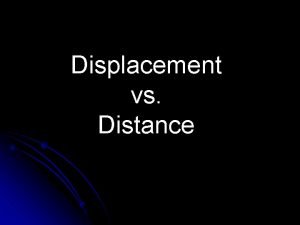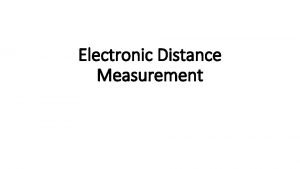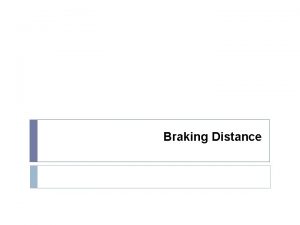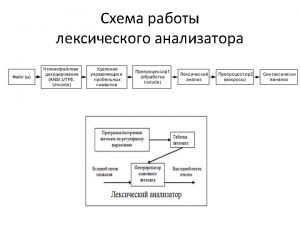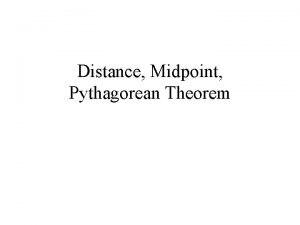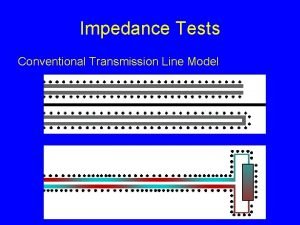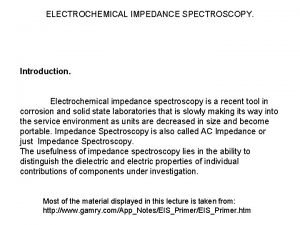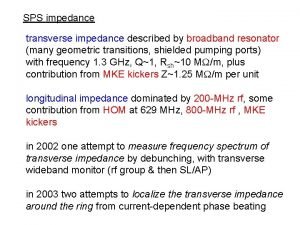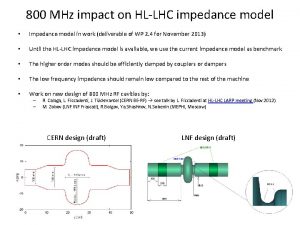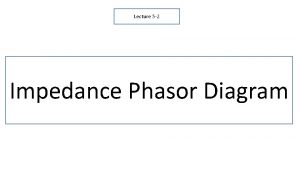Protection of Power Systems 8 Impedance Distance Relays











































- Slides: 43

Protection of Power Systems 8. Impedance (Distance) Relays

Zones of Protection n Protection of simple systems has been discussed so far. n For more general power system configurations, a fundamental concept is the division of a system into protective zones. n If a fault occurs anywhere within a zone, action will be taken to isolate that zone from the rest of the system. n Zones are defined for: generators, transformers, buses, transmission and distribution lines, and motors.

n Figure 10. 23 illustrates the protective zone concept. n Each zone is defined by a closed, dashed line. n Zone 1, for example, contains a generator and connecting leads to a transformer. n In some cases a zone may contain more than one component. n For example, zone 3 contains a generatortransformer unit and connecting leads to a bus, and zone 10 contains a transformer and a line.


n Protective zones have the following characteristics: Zones are overlapped. n Circuit breakers are located in the overlap regions. n For a fault anywhere in a zone, all circuit breakers in that zone open to isolate the fault. n Neighboring zones are overlapped to avoid the possibility of unprotected areas. n Without overlap the small area between two neighboring zones would not be located in any zone and thus would not be protected. n

n Since isolation during faults is done by circuit n n breakers, they should be inserted between equipment in a zone and each connection to the system. That is, breakers should be inserted in each overlap region. As such, they identify the boundaries of protective zones. For example, zone 5 in Figure 10. 23 is connected to zones 4 and 7. Therefore, a circuit breaker is located in the overlap region between zones 5 and 4, as well as between zones 5 and 7.

n If a fault occurs anywhere within a zone, action is n n taken to open all breakers in that zone. For example, if a fault occurs at P 1 on the line in zone 5, then the two breakers in zone 5 should open. If a fault occurs at P 2 within the overlap region of zones 4 and 5, then all five breakers in zones 4 and 5 should open. Clearly, if a fault occurs within an overlap region, two zones will be isolated and a larger part of the system will be lost from service. To minimize this possibility, overlap regions are kept as small as possible.

n Overlap is accomplished by having two sets of instrument transformers and relays for each circuit breaker. n For example, the breaker in Figure 10. 24 shows two CTs, one for zone 1 and one for zone 2. n Overlap is achieved by the order of the arrangement: first the equipment in the zone, second the breaker, and then the CT for that zone.





Line Protection with Impedance (Distance) Relays n Coordinating time-delay overcurrent relays can also be difficult for some radial systems. n If there are too many radial lines and buses, the time delay for the breaker closest to the source becomes excessive. n Also, directional overcurrent relays are difficult to coordinate in transmission loops with multiple sources. n Consider the use of these relays for the transmission loop shown in Figure 10. 27.


n For a fault at P 1, we want the B 21 relay to operate n n faster than the B 32 relay. For a fault at P 2, we want B 32 faster than B 13. And for a fault at P 3, we want B 13 faster than B 21. Proper coordination, which depends on the magnitudes of the fault currents, becomes a tedious process. Furthermore, when consideration is given to various lines or sources out of service, coordination becomes extremely difficult.

n To overcome these problems, relays that respond to a voltage-to-current ratio can be used. n Note that during a three-phase fault, current increases while bus voltages close to the fault decrease. n If, for example, current increases by a factor of 5 while voltage decreases by a factor of 2, then the voltage-to-current ratio decreases by a factor of 10. n That is, the voltage-to-current ratio is more sensitive to faults than current alone.

n A relay that operates on the basis of voltage-ton n current ratio is called an impedance relay. It is also called a distance relay or a ratio relay. Impedance relay block and trip regions are shown in Figure 10. 28, where the impedance Z is defined as the voltage-to-current ratio at the relay location. The relay trips for Z < Zr , where Zr is an adjustable relay setting. The impedance circle that defines the border between the block and trip regions passes through Zr.


n A straight line called the line impedance locus is shown for the impedance relay in Figure 10. 28. n This locus is a plot of positive sequence line impedances, predominantly reactive, as viewed between the relay location and various points along the line. n The relay setting Zr is a point in the R-X plane through which the impedance circle that defines the trip-block boundary must pass.

n Consider an impedance relay for breaker B 12 in Figure 10. 27, for which Z = V 1/I 12. n During normal operation, load currents are usually much smaller than fault currents, and the ratio Z has a large magnitude (and some arbitrary phase angle). n Therefore, Z will lie outside the circle of Figure 10. 28, and the relay will not trip during normal operation.

n During a three-phase fault at P 1, however, Z appears to relay B 12 to be the line impedance from the B 12 relay to the fault. n If Zr in Figure 10. 28 is set to be larger than the magnitude of this impedance, then the B 12 relay will trip. n Also, during a three-phase fault at P 3, Z appears to relay B 12 to be the negative of the line impedance from the relay to the fault. n If Zr is larger than the magnitude of this impedance, the B 12 relay will trip.

n Thus, the impedance relay of Figure 10. 28 is not directional; a fault to the left or right of the relay can cause a trip. n Two ways to include directional capability with an impedance relay are shown in Figure 10. 29. n In Figure 10. 29(a), an impedance relay with directional restraint is obtained by including a directional relay in series with an impedance relay, just as was done previously with an overcurrent relay.


n In Figure 10. 29(b), a modified impedance relay is obtained by offsetting the center of the impedance circle from the origin. n This modified impedance relay is sometimes called an mho relay. n If either of these relays is used at B 12 in Figure 10. 27, a fault at P 1 will result in a trip decision, but a fault at P 3 will result in a block decision.

n Note that the radius of the impedance circle for the modified impedance relay is half of the corresponding radius for the impedance relay with directional restraint. n The modified impedance relay has the advantage of better selectivity for high power factor loads. n For example, the high power factor load ZL lies outside the trip region of Figure 10. 29(b) but inside the trip region of Figure 10. 29(a).

n The reach of an impedance relay denotes how far down the line the relay detects faults. n For example, an 80% reach means that the relay will detect any (solid three-phase) fault between the relay and 80% of the line length. n This explains the term distance relay.

n It is common practice to use three directional impedance relays per phase, with increasing reaches and longer time delays. n For example, Figure 10. 27 shows three protection zones for B 12. n The zone 1 relay is typically set for an 80% reach and instantaneous operation, in order to provide primary protection for line 1– 2. n The zone 2 relay is set for about 120% reach, extending beyond bus 2, with a typical time delay of 0. 2 to 0. 3 seconds.


n The zone 2 relay provides backup protection for faults on line 1– 2 as well as remote backup for faults on line 2– 3 or 2– 4 in zone 2. n Note that in the case of a fault on line 2– 3 we want the B 23 relay to trip, not the B 12 relay. n Since the impedance seen by B 12 for faults near bus 2, either on line 1– 2 or line 2– 3, is essentially the same, we cannot set the B 12 zone 1 relay for 100% reach. n Instead, an 80% reach is selected to avoid instantaneous operation of B 12 for a fault on line 2– 3 near bus 2.

n For example, if there is a fault at P 2 on line 2– 3, B 23 should trip instantaneously; if it fails, B 12 will trip after time delay. n Other faults at or near bus 2 also cause tripping of the B 12 zone 2 relay after time delay. n Reach for the zone 3 B 12 relay is typically set to extend beyond buses 3 and 4 in Figure 10. 27, in order to provide remote backup for neighboring lines. n As such, the zone 3 reach is set for 100% of line 1– 2 plus 120% of either line 2– 3 or 2– 4, whichever is longer, with an even larger time delay, typically one second.

n Typical block and trip regions are shown in Figure 10. 30 for both types of three-zone, directional impedance relays. n Relay connections for a three-zone impedance relay with directional restraint are shown in Figure 10. 31.








n Remote backup protection of adjacent lines using zone 3 of an impedance relay may be ineffective. n In practice, buses have multiple lines of different lengths with sources at their remote ends. n Contributions to fault currents from the multiple lines may cause the zone 3 relay to underreach.

n The impedance relays considered so far use line-to- neutral voltages and line currents and are called ground fault relays. n They respond to three-phase, single line-to-ground, and double line-to-ground faults very effectively. n The impedance seen by the relay during unbalanced faults will generally not be the same as seen during three-phase faults and will not be truly proportional to the distance to the fault location. n However, the relay can be accurately set for any fault location after computing impedance to the fault using fault currents and voltages.

n For other fault locations farther away (or closer), the n n impedance to the fault will increase (or decrease). Ground fault relays are relatively insensitive to line-toline faults. Impedance relays that use line-to-line voltages Vab, Vbc, Vca and line-current differences Ia Ib, Ib Ic, Ic Ia are called phase relays. Phase relays respond effectively to line-to-line faults and double line-to-ground faults but are relatively insensitive to single line-to-ground faults. Therefore, both phase and ground fault relays need to be used.

Homework 4

 Vector impedance meter block diagram
Vector impedance meter block diagram Impedance relay
Impedance relay Two types of baton exchange in relays
Two types of baton exchange in relays Nand with relays
Nand with relays Dominant off latching circuit
Dominant off latching circuit Per unit impedance calculation
Per unit impedance calculation Power traiangle
Power traiangle The ratio of input distance to output distance
The ratio of input distance to output distance What is the difference of distance and displacement
What is the difference of distance and displacement Machine protection systems
Machine protection systems Machine protection system
Machine protection system The protection of information in computer systems
The protection of information in computer systems Rhino marking
Rhino marking Machine protection system
Machine protection system Generator overvoltage protection
Generator overvoltage protection Variable impedance type series compensator
Variable impedance type series compensator A balanced delta connected load having an impedance 20-j15
A balanced delta connected load having an impedance 20-j15 Phasor diagram of rc series circuit
Phasor diagram of rc series circuit Earth loop impedance
Earth loop impedance Intrinsic impedance of lossy dielectric medium
Intrinsic impedance of lossy dielectric medium Output impedance of op amp
Output impedance of op amp Gain op amp formula
Gain op amp formula Series impedance voltmeter
Series impedance voltmeter Eli the iceman
Eli the iceman Transverse impedance of a string
Transverse impedance of a string Impedance triangle
Impedance triangle Impedance triangle
Impedance triangle 163 ent
163 ent Transmission line impedance
Transmission line impedance Jonathan eele
Jonathan eele Define intrinsic impedance
Define intrinsic impedance Couplage par impédance commune
Couplage par impédance commune Characteristic impedance of air
Characteristic impedance of air Zener vs normal diode
Zener vs normal diode Parallel rc circuit impedance
Parallel rc circuit impedance Electrochemical impedance spectroscopy basics
Electrochemical impedance spectroscopy basics Abcd matrix transmission line
Abcd matrix transmission line Attenuation constant formula
Attenuation constant formula Q factor of series rlc circuit
Q factor of series rlc circuit Y=1/z impedance
Y=1/z impedance S domain circuit analysis
S domain circuit analysis A balanced delta connected load having an impedance 20-j15
A balanced delta connected load having an impedance 20-j15 Impedance matrix example
Impedance matrix example Impedance threshold device
Impedance threshold device
